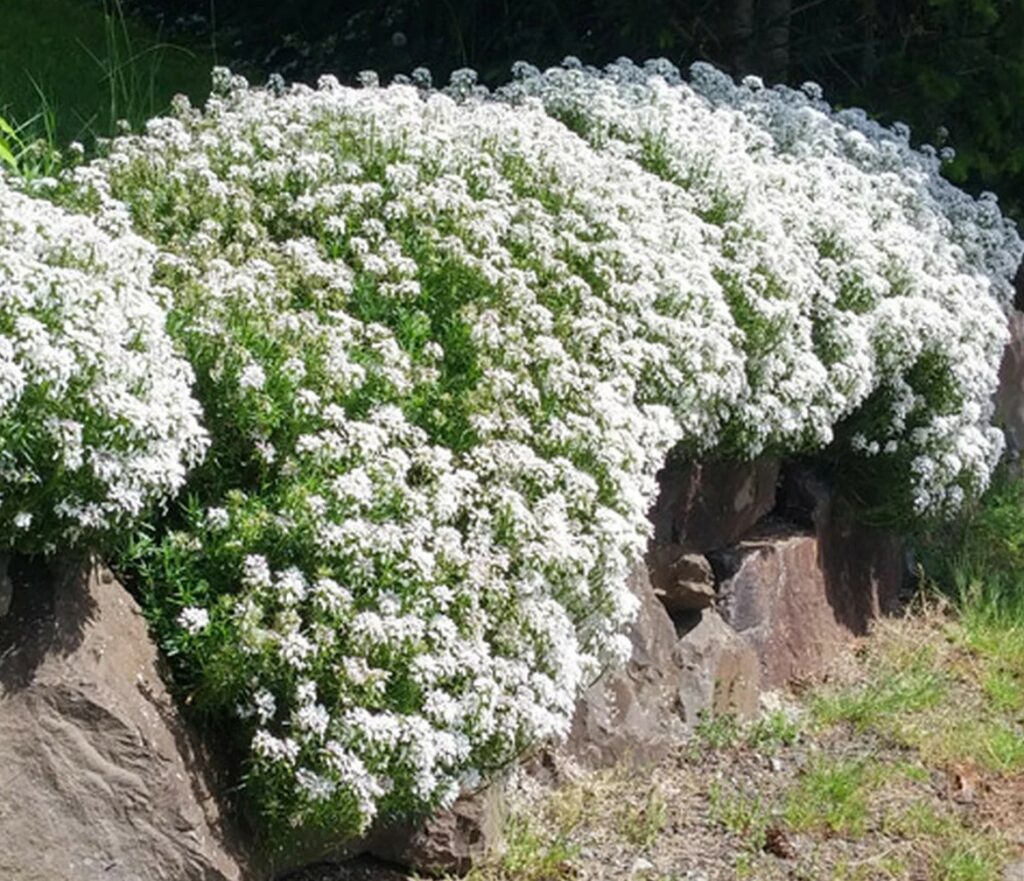by Ken Lain, the mountain gardener

Masses of fragrant white blooms cover mounds of green foliage. Extreme heat and cold tolerant, this award-winner repeatedly blooms without deadheading for super easy care. Butterflies, Bees, and Hummingbirds are going to love your backyard again.
Candytuft (Iberis sempervirens), a ground-hugging perennial flower frequently used as pathway edging, is a late bloomer that brightens gardens March through May. Best planted in early fall, it is a slow grower that brightens gardens for many years. Its white or pink blooms are abundant and showy. Masses of blinding white flowers dot the stems. The color of the blossoms stands out nicely against the backdrop of the dark green foliage.
The petals form a pretty pattern that never fails to hold your attention. The flowers have an unpleasant aroma; the scent is actually unpleasant, even to javelina and deer.
Botanical Name Iberis Sempervirens
Common Name Candytuft
Plant Type Perennial Flower
Mature Size 12″ inches tall
Sun Exposure Full sun to partial shade
Soil Type well drained soil
Soil pH 6.5 to 8
Bloom Time Spring
Flower Color White, pink, lilac
Hardiness Zones 4 to 8
Native Area Along the Mediterranean Coast
How to Grow Candytuft
Candytufts is considered an evergreen or semi-evergreen sub-shrub; most gardeners treat candytuft as they would any perennial flower. This flowering ground cover is part of the mustard, or cabbage, family.
When planting, space them about six inches apart in moist soil if you want a ground cover that fills quickly. To keep candytuft looking tidy, you can prune away the top one-third of the foliage after blooming and keeps them from getting leggy. When planting candytuft over a retaining wall, legginess may actually be perfect quality. In this case, prune them only if you think the stems are getting too woody-looking. Pruning will spawn new, fresh growth.
Light
Candytuft tolerates some shade but blooms best when planted in 6+ hours of sun. When the temperature exceeds 95 degrees, Candytuft benefits in a spot where the flower has partial shade in the afternoon.
Soil
The candytufts are native to southern Europe and the Mediterranean coast. They prefer well-drained soil and benefit from a rich mixture of Watters Premium Mulch or directly planted in Watters Potting Soil.
Water
Once established, candytuft flowers are drought-tolerant. Young plants do benefit from weekly water and bloom long when irrigated during dry periods.
Fertilizer
Poor soils seem to encourage more flowering than fertile soils. To maximize bloom count, use Flower Power twice per month during the growing season for more flowers plant than foliage.
Propagating Candytuft
If propagating from cutting, select a green, healthy stem that is a bit long or tall. While the stem will self-root, it does take a while. Be patient if you use this method. Propagating can also be done through root division in the fall, right before Candytufts begin their winter dormancy. One large plant can be divided into two to three new plants, and stems and roots are included in each clump.
Landscape Uses
Because candytuft flowers crave well-drained soils, they are perfect for rock gardens. Sedum and Angelina stonecrop make good companion plants grow with them. Their drought resistance also makes candytufts a good choice for xeriscaping.
Varieties of Candytuft
The name originates from the word “Candia,” an early name for Crete’s island, which was the source of the first plants imported to Europe. “Tuft” may refer to either the clusters of flowers or the mounded growth habit of the plant. The Latin genus name indicates the plant harkens from Spain and the Iberian peninsula (Iberia). In contrast, the second part of the name, the species identification sempervirens, indicates that the plant has evergreen foliage. The term is derived from the Latin words for “always” and “alive.”
‘Purity’ has white flowers, along with several other cultivars, such as:
- ‘Alexander’s White’
- ‘Snowflake’
- ‘Snowmantle’
- ‘Whiteout’
The cultivar ‘Pink Ice’ bears pink-colored blossoms. There are also related species that are annual: Iberis amara and Iberis umbellata.
Common Pests/Diseases
Candytufts are deer-resistant perennials and are also rabbit and javelina proof. This plant is mainly free of pests and most disease problems, although root rot can be an issue if planted in boggy soil.
Companion Plants with Candytuft for a Stunning Backyard
Arizona Gaillardia – The perfect mountain perennial with huge fiery flowers on a compact plant. She loves the heat and super drought hardy. You can count on this bloomer to show off all summer long in raised beds, containers, or directly in the ground. Javelina and rabbit proof, this bloomer is a ‘must-have.’ Arizona plant.
Perfume Lilac – The fragrance will remind you of visits to Grandmother’s house. A truly outstanding lilac for the large flowers and captivating fragrance, and super easy to grow. She is in a class by herself even in the hottest of sun locations. If fact, the more sun she receives the more flowers you will have.
Songbird Columbine – This graceful beauty dances in the shade of the garden, holding it’s head high smiling back at you. Few Plants stand so bright in the cooler parts of the garden. This bloomer comes back each spring with lacy green foliage promptly followed by an amazing two-tone flower. An excellent cut flower that is both Deer and Rabbit resistant. So hardy some varieties naturally call Arizona home.
Purple Twist Plum – This AZ plum is the ideal small purple tree between evergreens. Blooms in a profusion of pink flowers that precede the deep purple foliage. Large enough to use as a front yard tree, and behaved enough to use as a street tree. Plant pairs flanking gateways, driveways or in orchard like rows to screen a view of neighbors.

